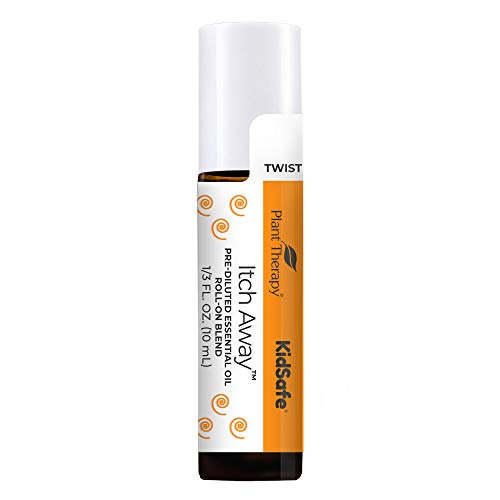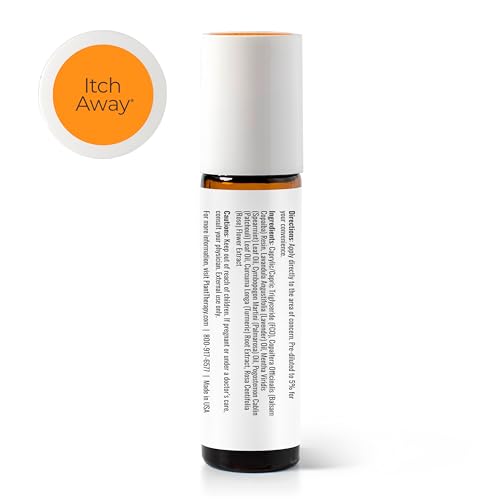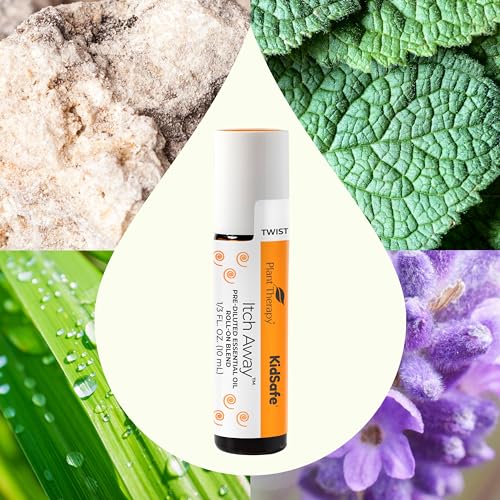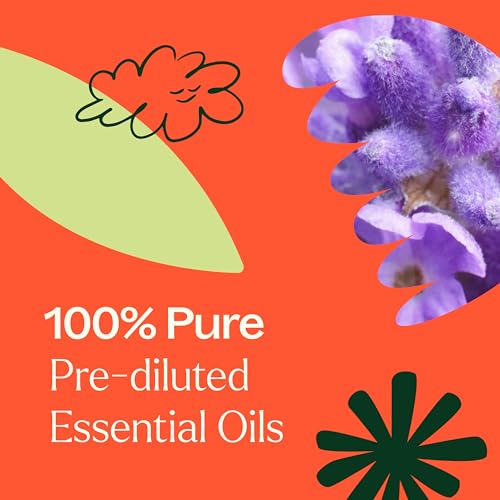






Plant Therapy Itch Away Essential Oil Blend - Soothes Skin Irritations, KidSafe Formula - 10 mL


Cymbopogon Martini (Palmarosa)
High RiskCymbopogon martini, commonly known as palmarosa, is a grass native to India and is primarily used for its essential oil, which serves as a fragrance and potential antibacterial agent in cosmetic formulations.
Sustai Insights
Palmarosa oil offers functional benefits including its use as a natural fragrance and potential antimicrobial properties. However, it has a high allergenic potential, posing risks of skin irritation and sensitization. Environmentally, it may not be significantly hazardous, but concerns about its cultivation practices exist. Regulatory bodies place some restrictions on its use, leading to an overall high risk assessment. Safe usage practices should be followed, and consideration for alternatives such as lavender or geranium oils may provide safer options.
Mentha Spicata (Spearmint)
High RiskMentha spicata, commonly known as spearmint, is a perennial herb in the mint family, often used in flavoring, fragrance, and medicinal products. It has a distinctive aroma and flavor, attributed to its essential oil content, primarily carvone. Spearmint is utilized for its potential soothing properties and its role in enhancing product sensory attributes.
Sustai Insights
Spearmint offers functional benefits as a flavoring and fragrance agent, contributing to sensory appeal in various products. However, it is associated with a high concern for allergies and immunotoxicity, while presenting low risks for carcinogenicity and developmental toxicity. Although not currently restricted, regulatory bodies recommend caution in its use due to these allergy concerns. The overall risk level is assessed as high, prompting careful consideration in product formulation, especially for sensitive populations. Alternatives such as peppermint or natural flavoring agents may be considered for safer formulation.
Fractionated Coconut Oil
Low RiskFractionated coconut oil is a refined version of coconut oil, where long-chain fatty acids are removed, leaving primarily medium-chain triglycerides. It is commonly used as a carrier oil in cosmetic products due to its lightweight texture and ability to penetrate the skin easily, making it suitable for moisturizing and massage applications.
Sustai Insights
Fractionated coconut oil offers functional benefits as an effective moisturizer and emollient, enhancing product texture and application. It is derived from sustainable sources and is biodegradable. Health risks are minimal, with low concerns for carcinogenicity, allergies, and reproductive toxicity. Environmentally, it does not present significant hazards. Regulatory assessments indicate no restrictions, supporting its low-risk profile. For safe usage, it is recommended to perform a patch test before extensive application. Alternatives include other lightweight oils such as jojoba or grapeseed oil, which may provide similar benefits.
Copaiba Oil
Low RiskCopaiba oil is an essential oil derived from the balsam of copaiba trees, primarily found in South America. It is commonly used in various products for its potential therapeutic properties, including anti-inflammatory and analgesic effects.
Sustai Insights
Copaiba oil offers functional benefits such as anti-inflammatory properties and is sustainably sourced from copaiba trees, contributing to its eco-friendliness. Health risks are minimal, with low concerns for carcinogenicity, allergies, and reproductive toxicity. Environmental risks are also low, with no significant pollutant or bioaccumulation concerns. Regulatory bodies, including the FDA, do not impose restrictions on its use. Overall, copaiba oil is assessed as having a low risk profile, making it a viable option in formulations.
Pogostemon Cablin (Patchouli)
Low RiskPogostemon cablin, commonly known as patchouli, is an aromatic plant widely used in perfumery, cosmetics, and traditional medicine. Its essential oil is extracted from the leaves and is valued for its distinctive scent and potential benefits in fragrance formulations and skin care products.
Sustai Insights
Patchouli oil offers functional benefits as a fragrance and potential antimicrobial agent. It is derived from a renewable source, contributing to sustainability. Health risks are minimal, with low concerns regarding carcinogenicity, allergies, and reproductive toxicity. Environmental risks are also low, with no significant pollutant or bioaccumulation concerns. Regulatory status is favorable, as it is not heavily restricted. Overall, the risk level associated with patchouli oil is low, making it a suitable ingredient in various applications.
Lavandula (Lavender) Flower
Low RiskLavandula (lavender) flower refers to unspecified preparations of the lavender plant, known for its aromatic properties. It is commonly used in various products for fragrance and potential therapeutic benefits, such as calming effects. The ingredient has a low risk profile regarding common health concerns.
Sustai Insights
Lavender flower offers functional benefits primarily as a fragrance and potential calming agent in products. It is considered sustainably sourced with low environmental impact and is not associated with significant health risks, such as carcinogenicity, allergies, or reproductive toxicity. Regulatory bodies, including the FDA, do not impose restrictions on its use. However, as with any ingredient, proper usage is recommended to mitigate any minor irritation risks. Overall, it presents a low-risk profile, making it a favorable choice in formulations.
Fractionated Coconut Oil
Low RiskFractionated coconut oil is a refined version of coconut oil, where long-chain fatty acids are removed, leaving primarily medium-chain triglycerides. It is commonly used as a carrier oil in cosmetic products due to its lightweight texture and ability to penetrate the skin easily, making it suitable for moisturizing and massage applications.
Sustai Insights
Fractionated coconut oil offers functional benefits as an effective moisturizer and emollient, enhancing product texture and application. It is derived from sustainable sources and is biodegradable. Health risks are minimal, with low concerns for carcinogenicity, allergies, and reproductive toxicity. Environmentally, it does not present significant hazards. Regulatory assessments indicate no restrictions, supporting its low-risk profile. For safe usage, it is recommended to perform a patch test before extensive application. Alternatives include other lightweight oils such as jojoba or grapeseed oil, which may provide similar benefits.
Copaiba Oil
Low RiskCopaiba oil is an essential oil derived from the balsam of copaiba trees, primarily found in South America. It is commonly used in various products for its potential therapeutic properties, including anti-inflammatory and analgesic effects.
Sustai Insights
Copaiba oil offers functional benefits such as anti-inflammatory properties and is sustainably sourced from copaiba trees, contributing to its eco-friendliness. Health risks are minimal, with low concerns for carcinogenicity, allergies, and reproductive toxicity. Environmental risks are also low, with no significant pollutant or bioaccumulation concerns. Regulatory bodies, including the FDA, do not impose restrictions on its use. Overall, copaiba oil is assessed as having a low risk profile, making it a viable option in formulations.
Cymbopogon Martini (Palmarosa)
High RiskCymbopogon martini, commonly known as palmarosa, is a grass native to India and is primarily used for its essential oil, which serves as a fragrance and potential antibacterial agent in cosmetic formulations.
Sustai Insights
Palmarosa oil offers functional benefits including its use as a natural fragrance and potential antimicrobial properties. However, it has a high allergenic potential, posing risks of skin irritation and sensitization. Environmentally, it may not be significantly hazardous, but concerns about its cultivation practices exist. Regulatory bodies place some restrictions on its use, leading to an overall high risk assessment. Safe usage practices should be followed, and consideration for alternatives such as lavender or geranium oils may provide safer options.
Pogostemon Cablin (Patchouli)
Low RiskPogostemon cablin, commonly known as patchouli, is an aromatic plant widely used in perfumery, cosmetics, and traditional medicine. Its essential oil is extracted from the leaves and is valued for its distinctive scent and potential benefits in fragrance formulations and skin care products.
Sustai Insights
Patchouli oil offers functional benefits as a fragrance and potential antimicrobial agent. It is derived from a renewable source, contributing to sustainability. Health risks are minimal, with low concerns regarding carcinogenicity, allergies, and reproductive toxicity. Environmental risks are also low, with no significant pollutant or bioaccumulation concerns. Regulatory status is favorable, as it is not heavily restricted. Overall, the risk level associated with patchouli oil is low, making it a suitable ingredient in various applications.
Lavandula (Lavender) Flower
Low RiskLavandula (lavender) flower refers to unspecified preparations of the lavender plant, known for its aromatic properties. It is commonly used in various products for fragrance and potential therapeutic benefits, such as calming effects. The ingredient has a low risk profile regarding common health concerns.
Sustai Insights
Lavender flower offers functional benefits primarily as a fragrance and potential calming agent in products. It is considered sustainably sourced with low environmental impact and is not associated with significant health risks, such as carcinogenicity, allergies, or reproductive toxicity. Regulatory bodies, including the FDA, do not impose restrictions on its use. However, as with any ingredient, proper usage is recommended to mitigate any minor irritation risks. Overall, it presents a low-risk profile, making it a favorable choice in formulations.
Mentha Spicata (Spearmint)
High RiskMentha spicata, commonly known as spearmint, is a perennial herb in the mint family, often used in flavoring, fragrance, and medicinal products. It has a distinctive aroma and flavor, attributed to its essential oil content, primarily carvone. Spearmint is utilized for its potential soothing properties and its role in enhancing product sensory attributes.
Sustai Insights
Spearmint offers functional benefits as a flavoring and fragrance agent, contributing to sensory appeal in various products. However, it is associated with a high concern for allergies and immunotoxicity, while presenting low risks for carcinogenicity and developmental toxicity. Although not currently restricted, regulatory bodies recommend caution in its use due to these allergy concerns. The overall risk level is assessed as high, prompting careful consideration in product formulation, especially for sensitive populations. Alternatives such as peppermint or natural flavoring agents may be considered for safer formulation.
Introducing the Itch Away Essential Oil Blend from Plant Therapy, a natural solution crafted to alleviate skin irritations and discomfort. This soothing blend is perfect for families seeking relief from bug bites and minor skin issues.
- Natural Ingredients: Formulated with Copaiba, Lavender, and more.
- KidSafe Formula: Gentle and safe for all ages, including children.
- Soothing Aroma: Sweet, floral scent that calms and comforts.
- Quality Assurance: Batch-specific GC-MS reports ensure purity.
- Affordable Luxury: High-quality essential oils at direct-to-consumer prices.
- Expert Support: Certified Aromatherapists available for guidance.
- Satisfaction Guaranteed: Risk-free purchase with a 100% satisfaction promise.
Subscribe & Save with Sustai
- Best Price Guarantee: Always enjoy the lowest prices on sustainable home essentials.
- No Surprises: We’ll notify you before shipping. No hidden fees, ever.
- You’re in Charge: Change, pause, or cancel your subscription anytime with ease.
- Eco-Friendly Deliveries: Our grouped shipments mean less packaging and lower emissions.
Join us on a sustainable journey. Special offers for a limited time! Prices and promotions may change.
Recommended Products
Introducing the Itch Away Essential Oil Blend from Plant Therapy, a natural solution crafted to alleviate skin irritations and discomfort. This soothing blend is perfect for families seeking relief from bug bites and minor skin issues.
- Natural Ingredients: Formulated with Copaiba, Lavender, and more.
- KidSafe Formula: Gentle and safe for all ages, including children.
- Soothing Aroma: Sweet, floral scent that calms and comforts.
- Quality Assurance: Batch-specific GC-MS reports ensure purity.
- Affordable Luxury: High-quality essential oils at direct-to-consumer prices.
- Expert Support: Certified Aromatherapists available for guidance.
- Satisfaction Guaranteed: Risk-free purchase with a 100% satisfaction promise.

You can have at most 2 Sustainable Steals products in your cart
Customer Reviews
Customers’ View
Customers appreciate the effectiveness and natural formulation of the Itch Away Essential Oil Blend, noting its ability to provide relief from skin irritations such as bug bites and rashes. Many users highlight the soothing aroma and the kid-safe formula, making it suitable for families. For instance, one customer mentioned that it worked well for a plant-induced rash, while another expressed satisfaction with its ability to calm mosquito bites. The natural ingredients, including Copaiba and Lavender, resonate with health-conscious consumers, emphasizing a preference for eco-friendly solutions. Overall, this essential oil blend is viewed as a reliable and gentle option for alleviating discomfort, aligning with sustainable lifestyle choices.
AI-generated from the text of customer reviewsThis product is rated 4.3 of 5.0 stars.
It has received 4 reviews.




